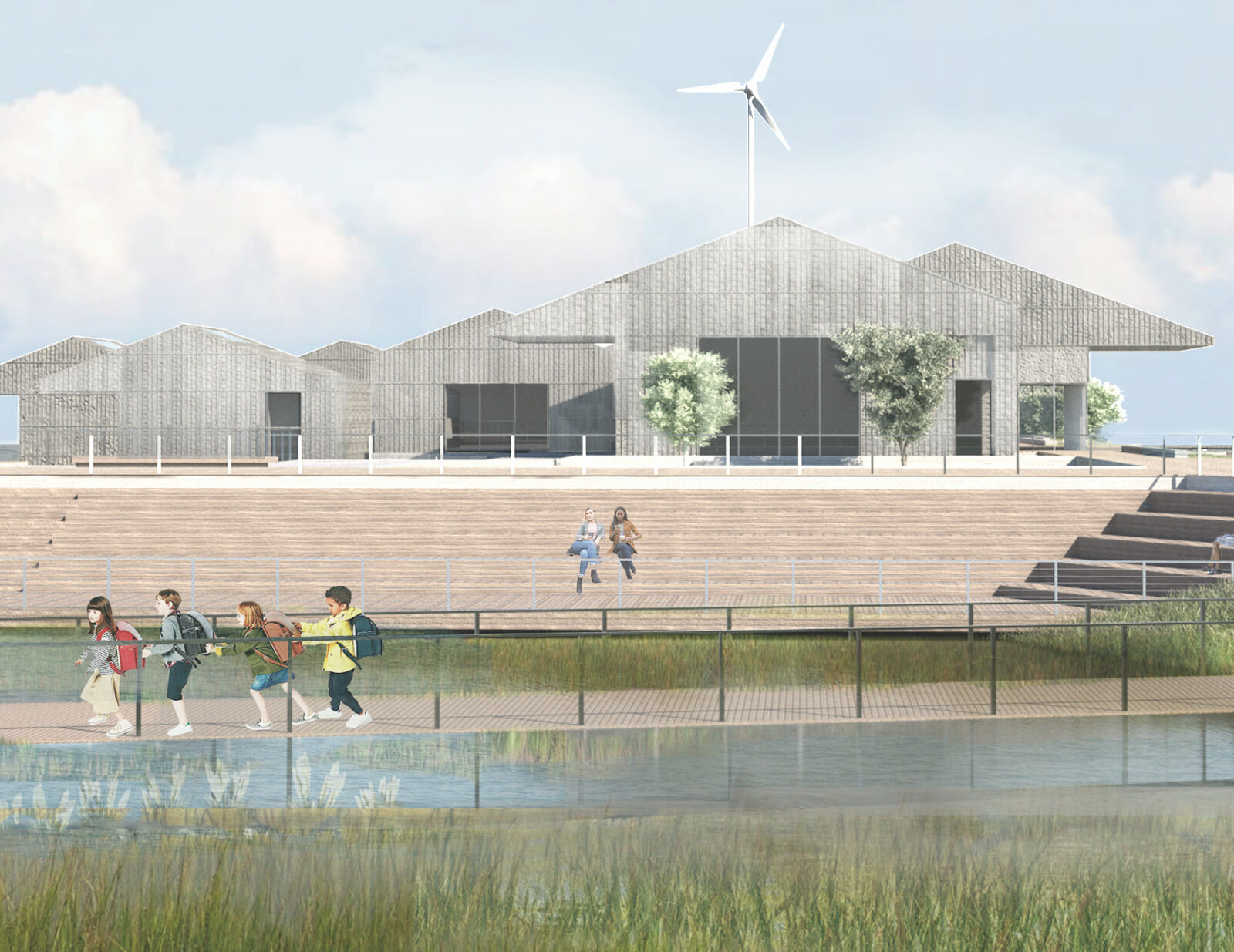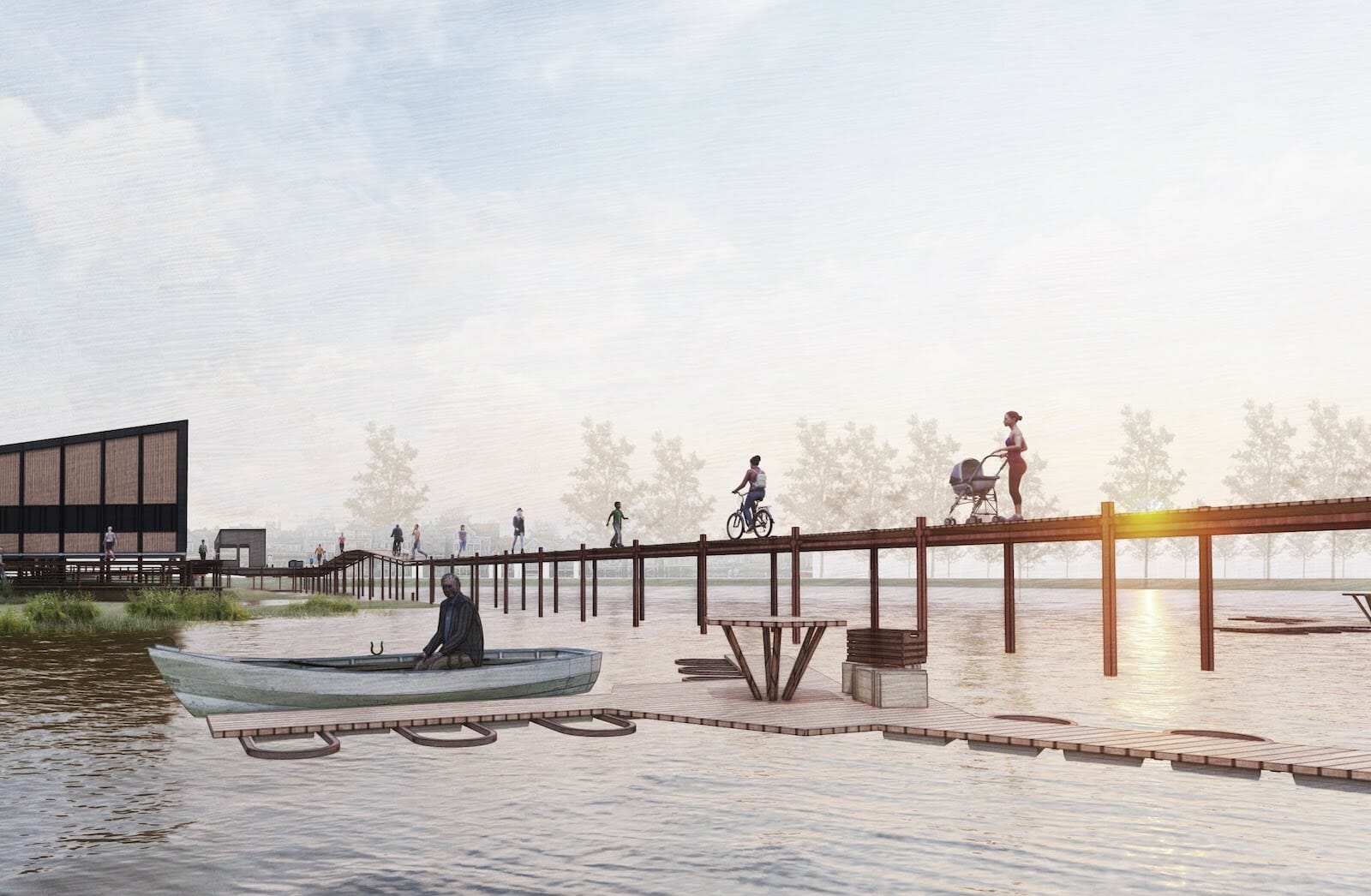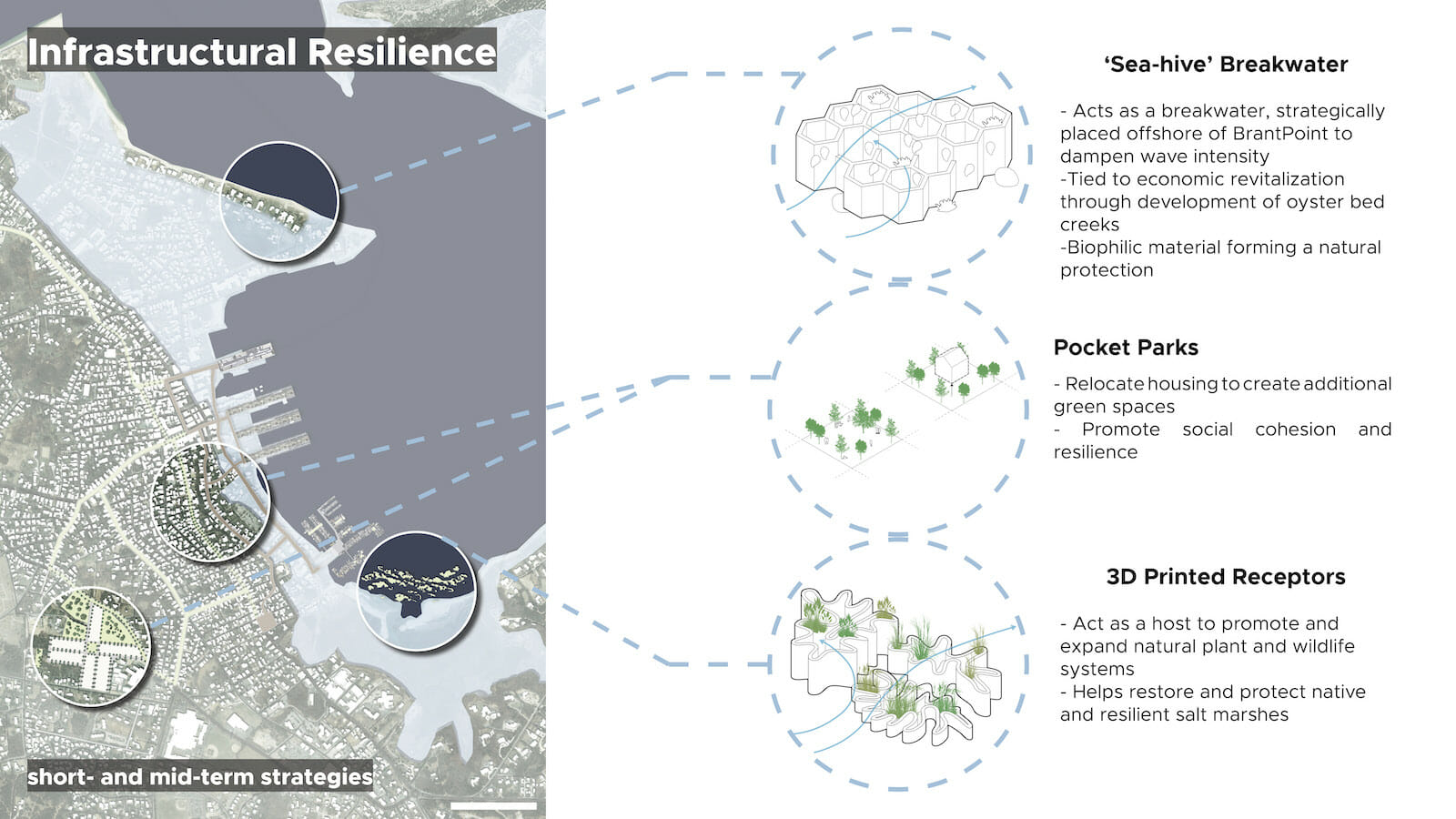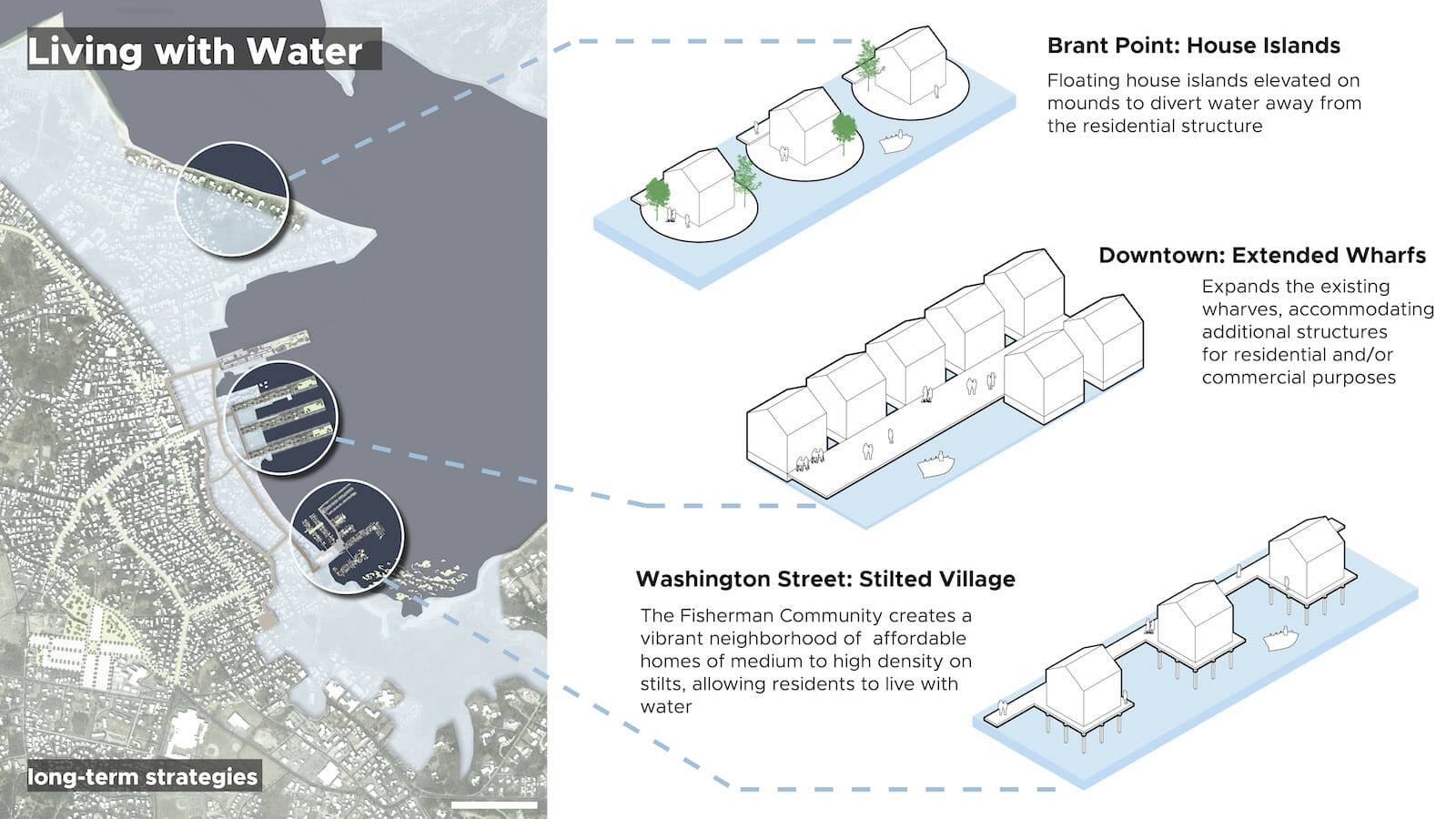Designs for Living with Rising Seas
Students Envision an Adaptive Future

Looking into the Marshland from ‘A Working Waterfront’ by Niema Jafari, Xuefeng Du, and Kevin Gao – Image courtesy of Yale University
By Claire Martin, Project Manager, ReMain Nantucket
Coastal communities are on the front lines of our generation’s most imminent threat: climate change. We see the impacts of this daily, even when the seas are calm and the sun is shining.
At a continuously increasing rate, coastal ecosystems are threatened by the acidification of the ocean, homes and dunescapes are lost to erosion, sedimentation and rising groundwater levels, and low-lying neighborhoods and wetlands are regularly inundated with water from high tides, storm surge, and sunny day flooding. By the mid-century, oceanside towns and cities around the world will likely be under several feet of water due to rising sea levels.
How does a community imagine a future with rising seas and regularly flooded buildings and roadways? Will neighborhoods retreat or adapt? What deserves to be protected or saved and who gets to make those decisions? How long will it take for policy on the local, state, and federal levels to catch up with innovative solutions that allow our communities to live with water?
Design, by nature, is a catalyst for change. After all, human beings need to be able to envision and imagine something before they can begin to work toward it. In late 2019, ReMain Nantucket—an island-organization dedicated to strengthening the economic, social and environmental vitality of downtown Nantucket—set out to discover how design might impact decisions and attitudes around coastal resilience. Could design reach across disciplines and allow coastal residents to consider the future impacts of climate change and rising seas with a hopeful lens? Could graduate students be a powerful vehicle for painting a picture of an adaptive Nantucket waterfront that inspires change?
Sunny day flooding, also known as nuisance flooding or high-tide flooding, continues to set records year after year, measured by data collected from the National Oceanic and Atmospheric Association’s 98 tide gauges set along the U.S. coastline. In July, the National Oceanic and Atmospheric Administration (NOAA) released its 2021 State of High Tide Flooding and Annual Outlook report. High-tide flooding in coastal communities in the U.S. continued to set records in 2020, a trend that experts expect will only continue. Between May 2020 and April 2021, the number of sunny day flooding events across 14 coastal communities was the same or set a new record as the prior year. During that same time period, the number of high-tide flooding days was double what it was in the early 2000s. The report authors predict that by 2050, there will be 25 to 75 high-tide flooding days each year in U.S. coastal communities.1
Right as the Town of Nantucket officially adopted NOAA’s high scenario sea level rise projections for planning purposes in September of 2020, ReMain Nantucket had developed a model that would bring together the insights of local experts, the innovative thinking of graduate students, and the stories of people who call the island home. The model came to be called the Envision Resilience Nantucket Challenge,2 a spring 2021 virtual design studio led by Carolyn Cox of the University of Florida’s Florida Climate Institute. There were five participating universities: the University of Florida College of Design, Construction and Planning, Harvard University Graduate School of Design, University of Miami School of Architecture, the School of Architecture at Northeastern University, and the Yale School of Architecture.

Northeastern student Ke-Ping (Cammy) Kuo’s concept for an integrated coastline protection and aquaculture structure; image courtesy of Northeastern University

Rendering by Erika Blandon; image courtesy of the University of Florida
The goal of the Envision Resilience Nantucket Challenge was to inspire the community to imagine a future that is adaptive in the face of sea level rise; to empower residents in coastal communities around the world to imagine rising water in a positive, even hopeful, way. Instead of being consumed by fear, the questions became, can we live productively and positively with rising sea levels? Can we adapt in ways that view increased water as an opportunity rather than a threat?
For coastal communities, including island communities like Nantucket, the data can be staggering. By 2050, an estimated 900 buildings on Nantucket and Martha’s Vineyard could see daily high-tide flooding.3 That’s according to The Trustees of Reservations 2021 State of the Coast report, which highlighted probabilities of extreme storm events under which Nantucket could see 69 miles of flooded roadway and 1,436 flooded structures in the event of a 10-year storm and 95 miles of flooded roadway and 1,932 flooded structures in the event of a 100-year storm. The report emphasized that vulnerable communities, like the islands off the coast of Massachusetts, have just 10 to 20 years before the impacts of a changing climate are lapping at the front door and the ability for the community to change and adapt is no longer viable.
Today, however, students who took part in the Envision Resilience Nantucket Challenge might not see those numbers as staggering. Where some typically saw disaster, these designers saw opportunity. Teams of students from leading design schools spent the spring semester collaborating to reimagine development and use along the Nantucket waterfront. Guided by the leadership of advisory committee co-chairs Morris (Marty) Hylton III—historic architect for climate change adaptation for the National Park Service—and Robert Miklos—founding principal of designLAB architects—the teams took an iterative, design-driven approach focused on three study areas along the harbor:
Low-lying Brant Point neighborhood, which was built on wetlands and is thus one of the most vulnerable to increased storm-related and sunny day flooding.
The island’s historic downtown with ports for the only two ferry terminals offering service to the mainland.
Washington Street, which is the main artery for traffic in and out of downtown Nantucket and the only corridor large enough for trucks carrying fuel and food to access the rest of the island.
By April, the students—who were working across as many as 14 time zones and had not yet stepped foot on the island because of the Covid-19 pandemic—had pioneered a diverse array of adaptive designs for not just protecting, but enhancing the island’s infrastructure, coastline, neighborhoods, and public spaces against the impacts of sea level rise.
“I think one of the real benefits of the Challenge is that no one expects students to solve the problem,” said lead professor Jeff Carney, associate professor, School of Architecture, University of Florida. “They’re learning. So we’re freed from that responsibility, but at the same time we have a real opportunity to provoke the conversation around the issues of climate change. It’s really exciting for me to see communities rise to that opportunity.”
Proposals for an adaptive Nantucket4 included buoyant foundations for private residences, a flood-resilient town square, and green energy systems to replace existing grey infrastructure. Students proposed landscapes serving as retention basins, artificial reefs to curb storm surge and aid sand movement, permeable surfaces along major streets, and areas restored to natural sanctuaries. Several groups imagined new economies fueled by ecotourism and aquaculture.

Rendering by Alexander Boucher; image courtesy of the University of Florida
Instead of being consumed by fear, the questions became, can we live productively and positively with rising sea levels? Can we adapt in ways that view increased water as an opportunity rather than a threat?
“[This Challenge] is a brilliant use of academia,” said Professor Anne Tate of the Rhode Island School of Design during an internal jury review of student work in April. “People don’t know how to move forward if they can’t see where they’re going. Providing this plethora of visions and solutions, all packaged together in this very forward-looking and optimistic way, is an absolutely tremendous gift to Nantucket and to the public officials who are going to have to figure out how to move forward.”
So how does a community begin to imagine a future under rising sea levels? Did we decide what deserves to be saved and who will make those decisions? Can the work of the students influence leaders and constituents to inform policy and regulations?
These are big questions to tackle. And they certainly can’t begin to be tackled without first identifying the unique makeup of a town, the value systems of the community, and the livelihoods and ways of life of its inhabitants. But through the remarkable design work of the students, Nantucket as a community can envision a future that is wetter, but no less beautiful.

Image courtesy of the University of Miami

Image courtesy of the University of Miami

Images created by Casale Ulloa
The diversity, the thoughtfulness, and the integrity of the student presentations far exceeded all expectations in inspiring the ReMain Nantucket team and the advisors to look differently at issues of resilience and to perhaps take on these challenges with renewed strength. On June 2, the community of Nantucket gathered outdoors for a public presentation to learn from the five university teams and discuss how, in unison with coastal communities worldwide, we might learn to live with water.
“There’s something pretty magical about a community being able to bring together all of these students and academic professionals,” said Paula Christina Viala, a participating student on the University of Miami team. “That meaningful community engagement was a big takeaway of the Challenge for me. A lot of beautiful things can come out of that.”
Forums, exhibitions, and conversations like those that the Envision Resilience Nantucket Challenge continues to foster are essential in moving coastal communities forward in the face of sea level rise and the impacts of climate change. The hope through this Challenge is that beyond the island of Nantucket, coastal towns and cities around the world are also inspired by the innovative and adaptive proposals of the students to be creative and bold in envisioning a resilient future.
ReMain Nantucket and ReMain Ventures are funded by Wendy Schmidt and her husband Eric to support the economic, social, and environmental vitality of the island of Nantucket.
In addition to providing grants and sponsorships to support sustainable and cultural initiatives across the island, ReMain Nantucket has worked in conjunction with ReMain Ventures to revitalize the downtown district year-round through the preservation of historic buildings that are home to a mix of nonprofit and commercial businesses.
For more information, visit envisionresilience.org
- https://tidesandcurrents.noaa.gov/publications/2021_State_of_High_Tide_Flooding_and_Annual_Outlook_Final.pdf
- https://www.envisionresilience.org
- https://static1.squarespace.com/static/5ce308a7514487000112e19b/t/610729cb96cbc243b9e38fdb/1627859414380/SOC_2021_IslandsReport_Web.pdf
- https://www.envisionresilience.org/meet-the-teams
